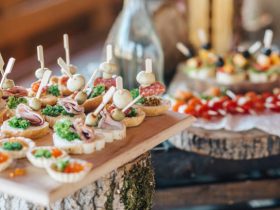Pepper shrimp is a street cuisine that originated in Middle Quarters, a community in the Parish of St. Elizabeth near the Black River, where the shrimp are collected. The shrimp are frequently referred to as crayfish, despite the fact that the Black River is home to two distinct species, one native freshwater shrimp and the other an intrusive crayfish. River shrimp are small with soft shells and can be eaten whole, plucked from the river in bamboo traps, a tool and method of obtaining freshwater shrimp thought to have been brought to the island by West African slaves some centuries ago. However, due to supply changes caused by weather, season, and demand, they are used interchangeably with saltwater shrimp; it is not uncommon to see merchants offering both river and ocean shrimp side by side, for the buyer to pick.
Making Jamaican Pepper Shrimp Red with Annatto
Their unusual brilliant red colour serves as both an advertisement and a warning: these shrimp are scorching. The vibrant colour, which is formed by a combination of the cooked shells, an intensive amount of crushed Scotch bonnet peppers, and, often, a dosage of red food colouring, can be the most difficult ingredient to imitate for people who want to make pepper shrimp at home. It’s okay to use food colouring to make pepper shrimp, but I wanted to find something else, something less synthetic, that would give my shrimp a more authentic red hue while also paying homage to Jamaica’s culinary history.
That exposed me to annatto, commonly known as achiote. The indigenous Taino people of Jamaica used annatto trees, from their bark to their seeds, to dye clothing and skin different shades of red and orange. It has also been used for a long time as a food colouring for yellow cheeses. Despite having a light earthy and smokey flavour, annatto is largely utilised for its colour nowadays and is easily accessible in the form of seeds, paste, powder, and oil.
I add annatto powder and, optionally, annatto seed oil in this recipe so that the shrimp can marinate in it and pick up some of its distinctive colour. The amount of spice has been reduced, but the dish is still hot. This is similar to the pepper shrimp sold in Jamaica.
It is important to note that the hottest shrimp will be produced by finely chopping the peppers and including their seeds (as well as by using more Scotch bonnet peppers overall in the recipe), whereas leaving the peppers whole or even removing the seeds significantly reduces the heat.

Ingredients
- 3 Scotch bonnet chili peppers
- 455g large shell-on shrimp, preferably head-on, rinsed
- Half of 1 medium-sized red bell pepper, stemmed, seeded, and finely diced
- Half of 1 medium-sized yellow onion, finely diced
- 4 stems fresh thyme
- 3 medium-sized garlic cloves, minced
- 1 tablespoon (15ml) annatto oil or vegetable oil
- 1 ½ teaspoons salt, plus more if needed
- 1 ½ teaspoons annatto (achiote) powder
- ½ teaspoon garlic powder
- ½ teaspoon onion powder
- 1 ½ cups water
- 2 tablespoons distilled white vinegar
- 6 allspice berries
Directions
- Prepare Scotch bonnet peppers while wearing latex gloves; the method will depend on your level of heat tolerance. Stem, seed, and chop or slice peppers for a very hot heat; stem, seed, and chop or slice peppers for a medium heat; and leave peppers whole, including stems, for a light heat.
- Add the shrimp to the medium bowl along with the Scotch bonnets, bell pepper, onion, thyme, garlic, annatto oil (or neutral oil), salt, and annatto, garlic, and onion powders. well-combined by stirring. Place in the fridge for at least 30 minutes and as long as overnight. Cover with plastic.
- Shrimp should be placed in a clean bowl and fragrant vegetables and herbs should be scraped off of them using gloves. Add water to the vegetable marinade before transferring the mixture to a stainless steel skillet big enough to fit the shrimp in one layer.
- Add the allspice berries, boil the mixture for 15 minutes with the lid on over medium heat.
- Reduce the heat to medium-low, add the vinegar, and stack the shrimp in the skillet. Cook, covered, for two minutes.
- When the shrimp are barely cooked through and no longer translucent, turn off the heat, uncover them, and stir them one more. If more salt is required, add it to the dish.
- Put the shrimp on a serving plate and give them some time to cool. Vegetables and cooking liquid should be thrown away. Serve the shrimp warm or at room temperature after they have been peeled at the table.











